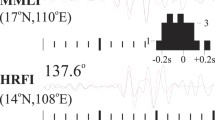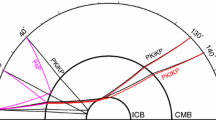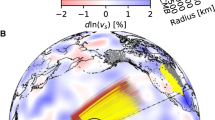Abstract
Multi-phase long-period t* measurements are among the key evidences for the frequency-dependent mantle attenuation factor, Q. However, similarly to Q, poorly constrained variations of Earth’s structure may cause spurious frequency-dependent effects in the observed t*. By using an attenuation-coefficient approach which incorporates measurements of geometric spreading (GS), such effects can be isolated and removed. The results show that the well-known increase of body P-wave t* from ~0.2 s at short periods to ~1–2 s at long periods may be caused by a small and positive bias in the underlying GS, which is measured by a dimensionless parameter γ* ≈ 0.06. Similarly to the nearly constant t* at teleseismic distances, this GS bias is practically range-independent and interpreted as caused by velocity heterogeneity within the crust and uppermost mantle. This bias is accumulated within a relatively thin upper part of the lithosphere and may be closely related to the crustal body-wave GS parameter γ ~ 4–60 mHz reported earlier. After a correction for γ, P-wave t P * becomes equal ~0.18 s at all frequencies. By using conventional dispersion relations, this value also accounts for ~40 % of the dispersion-related delay in long-period travel times. For inner-core attenuation, the attenuation coefficient shows a distinctly different increase with frequency, which is remarkably similar to that of fluid-saturated porous rock. As a general conclusion, after the GS is accounted for, no absorption-band type or frequency-dependent upper-mantle Q is required for explaining the available t* and velocity dispersion observations. The meaning of this Q is also clarified as the frequency-dependent part of the attenuation coefficient. At the same time, physically justified theories of elastic-wave attenuation within the Earth are still needed. These conclusions agree with recent re-interpretations of several surface, body and coda-wave attenuation datasets within a broad range of frequencies.





Similar content being viewed by others
References
Abercrombie RE (1998) A summary of attenuation measurements from borehole recordings of earthquakes: the 10 Hz transition problem. Pure Appl Geoph 153:475–487
Aki K, Chouet B (1975) Origin of coda waves: source, attenuation, and scattering effects. J Geophys Res 80:3322–3342
Aki K, Richards PG (2002) Quantitative seismology, 2nd edn. University Science Books, Sausalito
Anderson DL, Given JW (1982) Absorption band Q model for the Earth. J Geophys Res 87:3893–3904
Anderson DL, Minster JB (1979) The frequency dependence of Q in the Earth and implications for mantle rheology and Chandler wobble. Geophys J R Astr Soc 58:431–440
Anderson DL, Kanamori H, Hart RS, Liu H-P (1977) The Earth as a seismic absorption band. Science 196(4294):1104–1106. doi:10.1126/science.196.4294.1104
Azimi ShA, Kalinin AV, Kalinin VV, Pivovarov BL (1968) Impulse and transient characteristics of media with linear and quadratic absorption laws, Izvestiya, Phys. Solid Earth 2:88–93
Bhattacharyya J, Shearer PM, Masters G (1993) Inner core attenuation from short-period PKP (BC) versus PKP (DF) waveforms. Geophys J Int 114:1–11
Biot MA (1956) Theory of propagation of elastic waves in a fluid-saturated porous solid. J Acoust Soc Am 28:(a) 168–178, (b) 179–191
Bourbié T, Coussy O, Zinsiger B (1987) Acoustics of porous media. Editions TECHNIP, France, p 334, ISBN 2710805168
Carcione JM (2007) Wave fields in real media: Wave propagation in anisotropic anelastic, porous, and electromagnetic media, 2nd edn. Elsevier, Amsterdam
Cooper R (2002) Seismic wave attenuation: energy dissipation in viscoelastic crystalline solids. In: Karato S-I, Wenk HR (eds) Plastic deformation of minerals and rocks. Rev Mineral Geochem 51, pp 253–290
Cormier VF (1982) The effect of attenuation on seismic body waves. Bull Seism Soc Am 72:S169–S200
Cormier VF, Li X (2002) Frequency-dependent seismic attenuation in the inner core, 2. A scattering and fabric interpretation. J Geophys Res 107:2362. doi:10.1029/2002JB001796
Dahlen FA, Tromp J (1998) Theoretical global seismology. Princeton Univ Press, Princeton
Dainty AM (1981) A scattering model to explain seismic Q observations in the lithosphere between 1 and 30 Hz. Geophys Res Lett 8:1126–1128
Der ZA, Lees AC (1985) Methodologies for estimating t*(f) from short-period body waves and regional variations of t*(f) in the United States. Geophys J R Astr Soc 82:125–140
Der ZA, McElfresh TW (1976) Short-period P-wave attenuation along various paths in North America as determined from P-wave spectra of the Salmon nuclear explosion. Bull Seism Soc Am 66:1609–1622
Der ZA, McElfresh TW (1980) Time-domain methods, the values of t P * and t S * in the short-period band and regional variations of the same across the United States. Bull Seism Soc Am 70:921–924
Der ZA, Rivers WD, McElfresh TW, O’Donnell A, Klouda PJ, Marshall ME (1982) Worldwide variations in the attenuative properties of the upper mantle as determined from spectral studies of short-period body waves. Phys Earth Planet Inter 30:12–25
Der ZA, McElfresh TW, Wagner R, Burnetti J (1985) Spectral characteristics of P waves from nuclear explosions and yield estimation. Bull Seism Soc Am 75:379–390
Der ZA, Lees AC, Cormier VF (1986a) Frequency dependence of Q in the mantle underlying the shield areas of Eurasia, Part III: the Q model. Geophys J R Astr Soc 87:1103–1112
Der ZA, Lees AC, Cormier VF, Anderson LM (1986b) Frequency dependence of Q in the mantle underlying the shield areas of Eurasia, Part I: analyses of short and intermediate period data. Geophys J R Astr Soc 87:1057–1084
Doornbos DJ (1983) Observable effects of the seismic absorption band in the Earth. Geophys J R Astr Soc 75:693–711
Durek J, Ekström G (1996) A radial model of anelasticity consistent with long-period surface-wave attenuation. Bull Seismol Soc Am 86:144–158
Frankel A, McGarr A, Bicknell J, Mori J, Seeber L, Cranswick E (1990) Attenuation of high-frequency shear waves in the crust: measurements from New York State, South Africa, and southern California. J Geophys Res 95:17441–17457
Futterman WI (1962) Dispersive body waves. J Geophys Res 67:5279–5291
Jackson DD, Anderson DL (1970) Physical mechanisms of seismic-wave attenuation. Rev Geophys Space Phys 8:1–63
Kinoshita S (1994) Frequency-dependent attenuation of shear waves in the crust of the southern Kanto area, Japan. Bull Seism Soc Am 84:1387–1396
Knopoff L, MacDonald GJF (1958) Attenuation of small amplitude stress waves in solids. Rev Mod Phys 30:1178–1192
Lees AC, Der ZA, Cormier VF, Marshall ME, Burnetti JA (1986) Frequency dependence of Q in the mantle underlying the shield areas of Eurasia, Part II: analyses of long period data. Geophys J R Astr Soc 87:1085–1101
Lekić V, Matas J, Panning M, Romanowicz B (2009) Measurement and implications of frequency dependence of attenuation. Earth Planet Sci Lett 282:285–293
Li X, Cormier VF (2002) Frequency-dependent seismic attenuation in the inner core, 1. A viscoelastic interpretation. J Geophys Res 107:2361. doi:10.1029/2002JB001795
Minster JB (1978a) Transient and impulse responses of a one-dimensional attenuation medium. I. Analytical results. Geophys J R Astr Soc 52:479–501
Minster JB (1978b) Transient and impulse responses of a one-dimensional attenuation medium. II. A parametric study. Geophys J R Astr Soc 52:503–524
Mitchell B (2010) Prologue and invitation to participate in a forum on the frequency dependence of seismic Q. Pure Appl Geophys 167:1129. doi:10.1007/s00024-010-0180-3
Morozov IB (2001) Comment on “High-frequency wave propagation in the uppermost mantle” by T. Ryberg and F. Wenzel. J Geophys Res 106:30715–30718
Morozov IB (2008) Geometric attenuation, frequency dependence of Q, and the absorption band problem. Geophys J Int 175:239–252
Morozov IB (2009a) Thirty years of confusion around “scattering Q”? Seism Res Lett 80:5–7
Morozov IB (2009b) Reply to “Comment on ‘Thirty years of confusion around ‘scattering Q’?’” by J. Xie and M. Fehler. Seism Res Lett 80:648–649
Morozov IB (2009c) On the use of quality factor in seismology. AGU Fall Meeting, San Francisco, CA, S44A-02
Morozov IB (2010a) On the causes of frequency-dependent apparent seismological Q. Pure Appl Geophys 167:1131–1146. doi:10.1007/s00024-010-0100-6
Morozov IB (2010b) Attenuation coefficients of Rayleigh and Lg waves. J Seismol. doi:10.1007/s10950-010-9196-5
Morozov IB (2010c) Seismological attenuation coefficient and Q. Seism Res Lett 81:307
Morozov IB (2010d) Seismological attenuation without Q, Trafford, ISBN 9781426945267, 376 pp
Morozov IB (2011a) Anelastic acoustic impedance and the correspondence principle. Geophys Prosp. doi:10.1111/j.1365-2478.2010.00890.x
Morozov IB (2011b) Mechanisms of geometric seismic attenuation. Annals Geophys 54:235–248
Morozov IB (2012) Mechanical-energy dissipation in terrestrial planets. I: physical models of anelasticity, J Geophys Res—Planets. http://seisweb.usask.ca/ibm/papers/Q/Morozov_Mechanics_2011.part1.preprint.pdf
Morozov IB, Morozova EA, Smithson SB (1998a) On the nature of the teleseismic Pn phase observed in the recordings from the ultra-long profile “Quartz”, Russia. Bull Seism Soc Am 88:62–73
Morozov IB, Morozova EA, Smithson SB, Solodilov LN (1998b) 2D image of seismic attenuation beneath the Deep Seismic Sounding profile QUARTZ, Russia. Pure Appl Geoph 153:311–343
Morozov IB, Zhang C, Duenow JN, Morozova EA, Smithson S (2008) Frequency dependence of regional coda Q: Part I. Numerical modeling and an example from peaceful nuclear explosions. Bull Seism Soc Am 98:2615–2628. doi:10.1785/0120080037
Niazi M (1971) Seismic dissipation in deep seismic zones from the spectral ratio of pP/P. J Geophys Res 76:3337–3343
Nielsen L, Thybo H, Morozov IB, Smithson SB, Solodilov LN (2003) Teleseismic Pn arrivals: influence of mantle velocity gradient and crustal scattering. Geophys J Int 152:F1–F7
Nussenzveig HM (1972) In: Bellman R (ed) Causality and dispersion relations, mathematics in science and engineering, v. 95. Academic, New York
Romanowicz B, Mitchell B (2007) Deep earth structure: Q of the Earth from crust to core. In: Schubert G (ed) Treatise on geophysics, 1. Elsevier, Amsterdam, pp 731–774
Ryberg T, Wenzel F (1999) High-frequency wave propagation in the uppermost mantle. J Geophys Res 104:10655–10666
Savage B, Komatitsch D, Tromp J (2010) Effects of 3D attenuation on seismic wave amplitude and phase measurements. Bull Seism Soc Am 100:1241–1251. doi:10.1785/0120090263
Sharrock DS, Main IG, Douglas A (1995) Observations of Q from the northwest Pacific subduction zone recorded at teleseismic distances. Bull Seism Soc Am 85:237–253
Shito A, Karato S-i, Park J (2004) Frequency dependence of Q in Earth’s upper mantle inferred from continuous spectra of body waves. Geophys Res Lett 31:L12603. doi:10.1029/2004GL019582
Xie J (2010) Can we improve estimates of seismological Q using a new “geometric spreading” model? Pure Appl Geophys 167:1147–1162. doi:10.1007/s00024-010-0188-8
Xie J, Fehler M (2009) Comment on “Thirty years of confusion around scattering Q” by Igor B. Morozov. Seism Res Lett 80:646–647
Yang X, Lay T, Xie X-B, Thorne MS (2007) Geometric spreading of Pn and Sn in a spherical Earth model. Bull Seism Soc Am 97:2053–2065. doi:10.1785/0120070031
Zhu T, Chun K-Y, West GF (1991) Geometric spreading and Q of Pn waves: an investigative study in western Canada. Bull Seism Soc Am 81:882–896
Acknowledgments
This research was supported by NSERC Discovery Grant RGPIN261610-03. This work was conducted in part during the author’s 2010 sabbatical visit at the Air Force Research Laboratory, Hanscom AFB, sponsored by the US National Research Council. I thank Dr. Anton Dainty for hosting this visit. I also thank two anonymous reviewers for constructive comments.
Author information
Authors and Affiliations
Corresponding author
Appendix: Phase-velocity dispersion
Appendix: Phase-velocity dispersion
Body-wave dispersion relations are often derived from Kramers–Krönig {XE “Kramers–Krönig”} integrals and relate the frequency dependence of phase velocity to Q. In this appendix, we show that the meaning of this Q corresponds to the “effective” Q e given in Eq. (3).
Following Aki and Richards (2002, pp. 167–169), consider a harmonic wave of frequency ω, travelling in a uniform medium with phase velocity V(ω) = ω/k, with spectral amplitude u(ω) = exp(–iωx/V ∞ + ikx − αx), where k(ω) is the wavenumber, α(ω) is the attenuation coefficient and V ∞ = V(ω)| ω → ∞. This expression describes a harmonic wave with an infinite-frequency onset at point x occurring at time t = 0. To ensure that also u (t) ≡ 0 for all t < 0 (causality), the Kramers–Krönig {XE “Kramers–Krönig”} identities require that the imaginary part of the wavenumber (α) is uniquely related to its real part (k) and vice versa. If we consider limits of α 0 = α(0) and V ∞ to be finite, then k(ω) turns out to be insensitive to α 0 and α(ω) is insensitive to V ∞, and the Kramers–Krönig integrals relate the deviations of k′ = k − ω/V ∞ and α′ = α − α 0 from these reference levels (ibid):
Parameters V ∞ and α 0 can also be viewed as regularization constants for the integrals in Eq. (18), which are otherwise divergent (Nussenzveig 1972).
Causality relations show that if some wave experiences attenuation (α > 0), it must also exhibit phase-velocity dispersion and vice versa. In principle, these equations allow expressing the phase-velocity spectrum if attenuation is known at all frequencies. However, these integrals converge very slowly near ω′ → ∞ and ω′ → ω, and therefore, much of the information required for using these expressions to predict either k(ω) or α(ω) lies in the regions of unphysically high or low frequencies.
The case of α proportional to ω is of particular interest because there exists good evidence for it in both observations (Morozov 2008, 2010a, b) and theory (Morozov 2010d). However, in this case, the integral in the first equation in Eq. (18) is divergent and needs to be regularized. Such regularization can be done, for example, by assuming that α ≈ α 0 + α 1 ω within the seismic frequency band but flattens out at some high frequencies |ω| ≫ ω 0 (modified after Azimi et al. 1968),
From Eq. (18), the corresponding phase slowness is only sensitive to α 1 and ω 0:
where C is yet another regularization constant which is formally equal infinity in order to satisfy a finite value of \( \mathop{{\lim }}\limits_{{\omega \to \infty }} V\left( \omega \right) = {V_{\infty }} \). We can remove this constant by switching the reference velocity from V ∞ to V 0 = V(ω 0):
Denoting, in accordance with our definition of Q e, 2α 1 = Q −1e /V 0, the velocity dispersion law becomes:
Equation (22) shows the general logarithmic phase-velocity increase with frequency in the presence of attenuation, which is supported by many attenuation models (e.g. Carcione {XE “Carcione, J.M.”} 2007). Parameters ω 0 and V 0 in Eq. (22) represent arbitrary constants on which the resulting values of phase velocities may depend very strongly. However, for Q and ω 0 satisfying πQ e ≫ |ln(ω/ω 0)| and consequently V ≈ V 0 within the observation frequency band, the ratios of V(ω) taken at frequencies ω 1 and ω 2 no longer depend on these regularization parameters (Aki {XE “Aki, K.”} and Richards {XE “Richards, P.G.”} 2002, p. 170):
This ratio is often transformed into the “physical dispersion” relation and attributed to the viscoelastic moduli (Dahlen and Tromp 1998; p. 218), for example:
The above equations can also be expressed as variations of V and μ with frequency:
In order to understand the meaning of Q in dispersion laws (25), it is useful to try adding another “relaxation mechanism” with a different ω 0 to Eq. (19):
By combining such terms, practically any monotonic α(ω) functions increasing not faster than ω can be constructed. It is easy to verify that subject to the same approximation V ≈ V 0, expression (23) becomes:
where 1/Q e,1,2 = 2V ∞ α 1,2. This shows that velocity dispersion is sensitive to the derivative dα/dω = α 1 + α 2 near ω = 0 rather than to the cutoff frequency ω 0. Therefore, the Q factor in expressions (22) and (23) should correspond to the derivative dχ/dω evaluated after the zero-frequency limit of χ is removed, which corresponds to our Q e value (Eq. (3)). This is reflected in our notation in Eqs. (22) and (23).
In summary, causality constraints require velocity dispersion in the presence of attenuation, and yet the exact form of this dispersion should be determined from the specific wave models. Normally, any mechanical system possessing a time-domain (Lagrangian) description should behave causally. Similarly, Kramers–Krőnig integrals require a frequency-dependent attenuation α(ω) at least at the very high and very low frequencies. However, for practical purposes, this requirement is not very useful because the low-frequency cutoff below which Q −1 must decrease is about 10−99 Hz for Q ≥ 30 (Futterman 1962). Thus, the causality principle only weakly constrains the properties of the medium and does not constrain any definite frequency dependence of V or Q within the seismological frequency band.
Rights and permissions
About this article
Cite this article
Morozov, I.B. Frequency dependence of long-period t* . J Seismol 17, 265–280 (2013). https://doi.org/10.1007/s10950-012-9315-6
Received:
Accepted:
Published:
Issue Date:
DOI: https://doi.org/10.1007/s10950-012-9315-6




